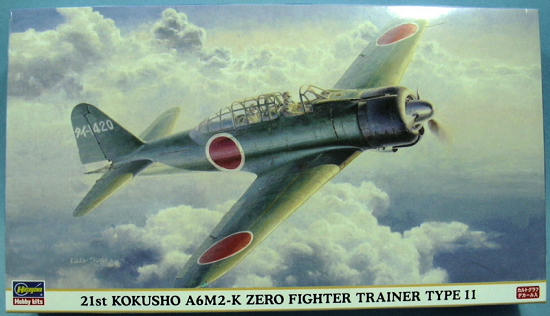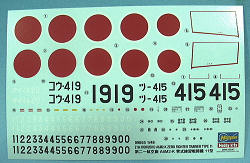
Hasegawa 1/48 A6M2-K Model 11
| KIT #: | 09855 |
| PRICE: | $44.95 MSRP |
| DECALS: | Three options |
| REVIEWER: | Tom Cleaver |
| NOTES: | Limited Release |

| HISTORY |
A
two-seater was developed by the Imperial Japanese Navy’s Flight Technology
Center No. 21 - the A6M2-K Model 11, modified from the Model 21 fighter. The
first conversion prototype flew in November 1942, with the first production
trainers coming off the production line in January 1943.
The Zero trainer used the same Sakae 12 engine, with the airframe identical
except that the cockpit was shifted forward to maintain the center of gravity
with an instructors cockpit behind the standard cockpit.
Two strakes were placed on the rear fuselage ahead of
the horizontal stabilizers for spin stabilization.
The student’s forward cockpit did not have a sliding
canopy. A sturdier, lighter, heavy-duty tail wheel replaced the small solid
rubber tire of the fighter.
The two 20mm cannon were removed from the wing to save
weight, while the 7.7mm machine guns in the fuselage were retained for gunnery
training.
Over 500 A6M2-Ks were produced until production ceased in July 1945. In addition to its use by flying schools, many front line units kept at least one trainer available for proficiency training as pilot standards continued to deteriorate through the war.
| THE KIT |
 Hasegawa has “owned” the Zero since they first released their A6M2 Model 21 in
the mid-1990s.
Over the years since, they have managed to release models of
every sub-type of Japan’s most famous airplane, including the original prototype
and ending with the A6M7.
This “Special version” provides a complete kit of the
A6M2, with two new sprues that include a modified fuselage and the interior
parts for a two-seat cockpit (shown), and new clear bits.
I have to say that this release is so “special” that it
has never shown up on the stock list at HobbyLink Japan, and I have only ever
heard one other modeler mention buying the kit.
According to Dave at my LHS, this kit I bought was
literally the o
Hasegawa has “owned” the Zero since they first released their A6M2 Model 21 in
the mid-1990s.
Over the years since, they have managed to release models of
every sub-type of Japan’s most famous airplane, including the original prototype
and ending with the A6M7.
This “Special version” provides a complete kit of the
A6M2, with two new sprues that include a modified fuselage and the interior
parts for a two-seat cockpit (shown), and new clear bits.
I have to say that this release is so “special” that it
has never shown up on the stock list at HobbyLink Japan, and I have only ever
heard one other modeler mention buying the kit.
According to Dave at my LHS, this kit I bought was
literally the o nly one of two that the distributor had.
nly one of two that the distributor had.
The parts are standard Hasegawa: crisp, with enough detail in the cockpit that one will only want to add seatbelts. The decals provide markings for three different A6M2-Ks, and there are sufficient serial number decals one could attempt just about any A6M2-K you have a photo of.
| CONCLUSIONS |
Review kit courtesy of my wallet.
May 2009
If you would like your product reviewed fairly and quickly, please contact me or see other details in the Note to Contributors.